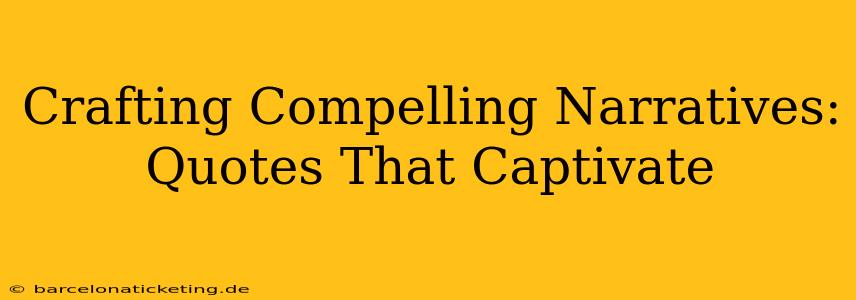Quotes. They're the literary equivalent of a perfectly placed spotlight, illuminating a character's inner world, advancing the plot, or leaving the reader breathless with contemplation. Masterfully integrated quotes aren't just decorative; they are the building blocks of compelling narratives, adding depth, texture, and emotional resonance to your storytelling. This guide delves into the art of using quotes effectively to captivate your audience.
Why Are Quotes So Powerful in Storytelling?
Quotes serve a multitude of purposes in crafting a narrative. They can:
- Reveal Character: A character's words, whether spoken aloud or thought internally, instantly reveal their personality, beliefs, and motivations. A single sentence can paint a vivid portrait more effectively than pages of description.
- Advance the Plot: A well-placed quote can hint at future events, create suspense, or offer crucial information that propels the story forward.
- Set the Tone and Atmosphere: Quotes can instantly establish the mood, whether it's lighthearted and playful or dark and brooding. The style and language used in a quote directly influence the overall feel of the scene.
- Evoke Emotion: Powerfully chosen words can evoke a wide range of emotions in the reader, creating empathy and a deeper connection with the characters and the story itself.
- Provide Contrast and Irony: The juxtaposition of contrasting quotes can highlight irony, create dramatic tension, or reveal hidden complexities within the narrative.
How to Use Quotes Effectively in Your Narrative
The secret to using quotes effectively lies in context and integration. Simply dropping a quote into your writing won't guarantee impact. Here's a breakdown of best practices:
- Show, Don't Just Tell: Instead of narrating a character's feelings, use a quote to show them. For example, instead of writing "John was angry," write, " 'This is unacceptable!' John roared, his face reddening."
- Vary Your Sentence Structure: Avoid always beginning a paragraph with a quote. Mix things up by integrating quotes into different sentence structures and placements.
- Use Action Tags: Use vivid action tags (verbs that describe how the character speaks) to enhance the impact of the quote. Instead of just "'Hello,' she said," try, "'Hello,' she whispered, her voice barely audible above the crashing waves."
- Consider the Character's Voice: Ensure the quote reflects the character's personality, background, and education level. A sophisticated lawyer would speak differently than a street urchin.
- Use Quotes Sparingly: Too many quotes can disrupt the flow of your narrative. Use them strategically to maximize their impact.
What Makes a Quote Captivating?
A captivating quote possesses several key qualities:
- Memorable Language: It employs strong imagery, vivid descriptions, or memorable phrasing.
- Emotional Impact: It evokes a strong emotional response from the reader, be it joy, sorrow, anger, or wonder.
- Relevance to the Narrative: It directly contributes to the plot, character development, or overall theme.
- Authenticity: It feels genuine and believable within the context of the story.
Common Mistakes to Avoid
- Overusing Quotes: Too many quotes interrupt the flow and make the story feel disjointed.
- Unnecessary Dialogue: Every quote should serve a purpose. Avoid including dialogue that doesn't advance the plot or reveal character.
- Inconsistent Voice: Ensure the quote aligns with the character's established voice and personality.
- Weak Action Tags: Vague or weak action tags diminish the impact of the quote.
How to Find Inspiring Quotes for Your Story
Inspiration can come from many sources:
- Real-Life Conversations: Pay attention to the memorable things people say around you.
- Literature and Poetry: Explore classic works and modern literature for inspiration.
- Movies and Television: Pay attention to dialogue that resonates with you.
- Songs and Lyrics: Music often contains powerful and evocative language.
By mastering the art of integrating quotes effectively, you can elevate your storytelling to a new level, captivating your readers and leaving a lasting impression.
Frequently Asked Questions
How do I choose the right quote for a specific scene?
The right quote will depend on the specific scene and its purpose. Consider what you want the quote to accomplish: reveal character, advance the plot, set the mood, or evoke emotion. Choose a quote that aligns with the character's personality and the overall tone of the scene.
Can I use quotes from other works in my own story?
While using direct quotes from other works is generally discouraged (copyright issues), you can draw inspiration from the style and tone of those quotes to craft your own unique dialogue.
How do I avoid making my dialogue sound unnatural?
Read your dialogue aloud. Does it sound like real people talking? If not, revise it until it feels authentic and believable. Pay attention to rhythm, pacing, and the use of colloquialisms and slang to ensure your dialogue sounds natural and engaging.
How can I make my quotes more impactful?
Use strong verbs and vivid imagery in your action tags. Ensure the quote itself is memorable and emotionally resonant. Consider the context and placement of the quote within your narrative to maximize its impact.
By carefully considering these points, you can transform your narratives into captivating experiences for your readers.

